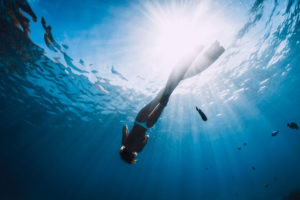While there is some controversy surrounding the name, shallow water blackouts — also called free-diver blackouts or hypoxic blackouts — are something that can potentially affect anyone who participates in water sports. Here’s some information on what shallow water blackouts entail and how to prevent them.
What are shallow water blackouts?
A shallow water blackout is a loss of consciousness or ‘fainting’ underwater, caused by a lack of oxygen to the brain while breath-holding. Despite its name, such a blackout can occur at any depth, although most cases do happen in water shallower than 30 feet (9 m).
How do they occur?
Your body registers both the amount of oxygen and carbon dioxide (CO2) in your blood. When the CO2 in your blood reaches a certain level, you reach what is called the ‘breakpoint.’ At the breakpoint, breath-hold divers surface and take a breath. If you reach the breakpoint while still underwater, you experience an uncontrollable urge to breathe, causing you to inhale water.
Hyperventilating before doing breath-hold diving decreases the amount of CO2 in the blood, meaning that while under pressure, a free diver may still have enough oxygen to sustain normal brain function without needing to breathe, due to lower levels of CO2. By the time CO2 levels reach the breaking point and the diver ascends, the drop in ambient pressure can lead to a decreased partial pressure of oxygen. The result is that the brain does not receive enough oxygen and the diver can black out.
Who is at most risk?

Generally speaking, anyone who participates in breath-hold diving or swimming is at risk. Free-divers, snorkelers, competitive swimmers and spear fishermen are more at risk of experiencing shallow water blackouts due to long breath-holding times and potential underwater exertion. While shallow water blackouts can happen to anyone, younger, more competitive men are also at higher risk.
How can you prevent them?
- The first and most important factor is education. The cause of death for many shallow water blackout victims is drowning. This means that there’s not enough awareness about the condition. Even competitive swimmers who have participated in the sport for decades are often unaware of the potential for blackouts, although they do know that hyperventilation and extended breath-holding can be dangerous.
- Avoid hyperventilation and exercise before or during breath-hold diving to help prevent shallow water blackouts.
- Don’t overweight yourself while breath-hold diving. Attempt neutral buoyancy at a depth of 15 feet (4.5 m).
- Ensure that your weight belt is quick-release and treat it — and any other equipment — as disposable. Let it go if you have to.
- Always train and dive with a buddy who is aware of shallow water blackouts, their signs, and how to treat them.
- Use a 2:1 recovery time with depths less than 60 feet (18 m) and 3:1 time with depth more than 60 feet or longer than 90 seconds. For example, if you dive to 60 feet or less, recover at the surface for two minutes after a 1-minute breath-hold dive.
Anyone involved in water sports faces the risk of shallow water blackouts. They are largely indiscriminate of age, gender and even fitness levels. The most important way to prevent one is through education, followed by avoiding hyperventilation and long or repetitive breath-hold dives.

